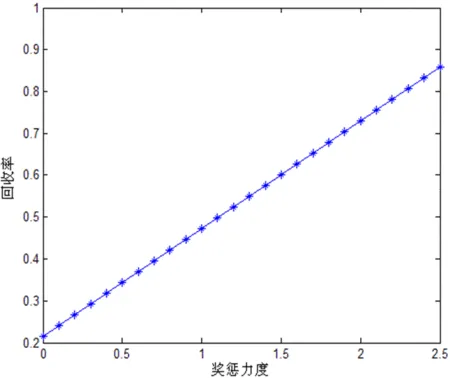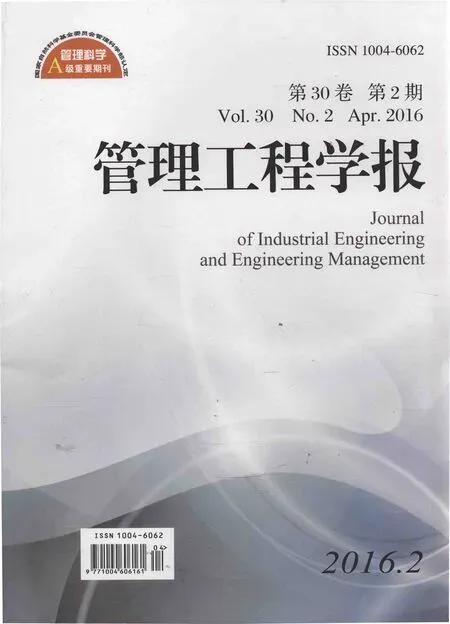碳排放约束下制造商竞争的逆向供应链政府奖惩机制研究
王文宾,邓雯雯,白 拓,达庆利,聂 锐
碳排放约束下制造商竞争的逆向供应链政府奖惩机制研究
王文宾1,邓雯雯1,白 拓1,达庆利2,聂 锐1
(1. 中国矿业大学管理学院,江苏徐州,221116;2. 东南大学经济管理学院,江苏南京,211189)
主要探讨碳排放约束下制造商竞争的逆向供应链奖惩机制,建立了5个决策模型,分别针对逆向供应链集中系统、带碳排放约束的逆向供应链集中系统、制造商竞争逆向供应链分散系统、碳排放奖惩机制下制造商竞争逆向供应链分散系统以及带有政府对制造商实施碳排放和回收率奖惩机制的逆向供应链系统。研究表明:竞争对回收率提高有益,竞争越激烈回收率越高;积极回收再制造的制造商的新产品零售价较低,具有价格竞争优势;回收废旧产品的制造商的单位碳排放量越小,与之竞争的不回收废旧产品的制造商的单位碳排放量越大,越有利于其回收率的提高;政府对制造商的回收率奖惩机制是必要的;碳排放约束不利于逆向供应链集中系统回收率的提高,且提高了制造商竞争逆向供应链分散系统的新产品价格。
竞争;碳排放;政府奖惩机制;逆向供应链;回收率
0 引言
许多因素正在促进逆向物流和逆向供应链的发展。这些因素包括:资源与环境问题日益凸显;消费者环保意识的增强;产品废弃周期的缩短导致很多潜在价值较大的废旧产品;政府法律法规的限制等。基于上述原因,逆向供应链引起了企业界、学术界及政界的广泛关注。
近年来国内外有一些文献致力于逆向物流与逆向/闭环供应链的研究。达庆利等(2004)[1]论述了逆向物流系统结构研究的现状并展望了未来的研究方向。Savaskan[2]分析了逆向供应链的结构选择问题。再制造逆向供应链问题涉及到不少利益相关者,要顺利实现废旧电器电子产品(Waste Electrical and Electronic Equipment,WEEE)的回收再制造,必须保证它们的利益协调。已有部分文献研究了再制造逆向供应链的协调问题。黄颖颖等[3]研究了逆向供应链的定价与激励机制。Kaya[4]研究了再制造产品与新制造产品部分可替代的决策。
政府是逆向供应链的利益相关者之一。达庆利[5]提出:政府法律法规和环保政策对回收再制造的影响是供应链管理领域值得关注的问题。Mitra和Webster[6]探讨了政府的再制造补贴对于制造商和再制造商利润的影响,通过比较只补贴再制造商、只补贴制造商及补贴制造商和再制造商,得到补贴由制造商和再制造商分享较好的结论。Chen和Sheu[7]利用微分对策建立了环境规制下制造商的定价模型,得到政府应逐渐提高规制标准,以便引导制造商逐步提高产品回收再利用水平等结论。Aksen[8]运用二层规划建立政府补贴制造商的两个模型,提出相同的回收率和收益率目标下,支持性比立法性政策需要政府提供更多的补贴。Atasu等[9]考虑了经济和环境的双重影响,建立了政府、制造商及消费者的博弈模型,政府给予制造商补贴以引导其回收再制造WEEE,讨论立法有效率的条件。晏妮娜[10]研究了第三方回收商和零售商回收情况下考虑环境立法对废钢回收的奖惩措施,建立废钢回收模型。计国君和黄位旺[11]以条例为背景,借鉴欧盟生产者延伸责任制,比较了企业单独回收和集体回收两种回收责任,得到单独回收责任下制造商更倾向于再制造的结论。
王文宾[12]初步探讨了政府针对制造商和回收商的逆向供应链奖励与奖惩机制,发现政府给予制造商比给予回收商奖惩机制更能调动制造商和回收商的积极性。王文宾[13]以奖惩力度和目标回收率为主要参数,探讨了政府的奖惩机制对制造商回收再制造决策的影响。聂佳佳等[14]讨论了零售商负责回收情况下政府针对零售商的奖惩机制对逆向供应链的影响。王文宾[15]比较了基于回收率和基于回收量的奖惩机制,讨论了两种机制的适用性,并比较了机制的优劣。朱庆华[16]建立了绿色供应链管理中考虑产品绿色度和政府补贴分析的三阶段博弈模型。Chen和Chang[17]研究了第三方负责再制造和再销售情况下的闭环供应链决策问题。
政府奖惩机制的许多优点已经在笔者前面的一些研究中得到了验证[12]-[15],[19]。然而鲜有考虑制造商竞争环境下奖惩机制的研究。现实中制造商面对激烈的市场竞争环境,而较少处于完全垄断的市场环境,特别是电器电子行业,在残酷的竞争环境下制造商的利润率只有3%-5%。由于利润率较低,不少企业担心回收再制造增加成本负担,因而不愿主动回收废旧产品。因此,竞争环境与完全垄断环境下政府奖惩机制的设计会有所不同,制造商竞争环境下逆向供应链的政府奖惩机制值得探索。
另一方面,低碳经济要求制造商生产新产品的碳排放量不能太高,高碳排放不仅浪费能源资源,而且污染空气,也影响人类健康。政府应该加大对企业碳排放的约束力度。借鉴WEEE回收所采用的奖惩机制思想,碳排放约束机制可以通过奖惩机制思想实施。碳税是政府对企业的常用做法,如果对碳排放量少的企业给予退税奖励,对碳排放量大的企业加重税,那么就能有效引导制造商走向低碳发展轨道,生产低碳产品,如果没有这种机制,容易造成劣币逐良币的结果。空气的污染跟固体污染同样需要给予重视,近年来中国不少城市的雾霾天气和空气质量破坏的事实说明,碳排放约束是必要的。而用这个视角审视闭环供应链的研究尚为鲜见。
本文考虑由两个制造商、一个回收商和消费者构成的逆向供应链,基于碳排放约束的制造商竞争环境下逆向供应链的政府奖惩机制如何设计才能有效引导制造商提高废旧产品的回收率?为探讨该问题,本文以回收率、目标回收率、奖惩力度等为主要参数,建立各种情况下制造商与回收商的博弈模型,得到各种情形下逆向供应链的定价和回收率决策,特别是通过比较回收率、新产品零售价的大小,探讨政府奖惩机制的规律,以期通过政府奖惩机制提高废旧产品的回收率。
1 问题描述
考虑区域内有少数几个电器电子产品制造商,市场结构为寡头垄断。不失一般性,不妨将寡头制造商数目设为两个,政府实施奖惩机制,假设一个制造商不回收再制造WEEE,另一个制造商回收再制造WEEE。为了表示方便,制造商为不回收再制造的制造商(这种类型的制造商对政府奖惩机制持消极态度,宁可被处罚也不回收再制造WEEE),制造商表示从事回收再制造的制造商。本文试图探讨政府奖惩机制引入后,两制造商竞争会受到什么影响,从而讨论如何设计奖惩机制才能更好的引导制造商积极回收再制造WEEE。根据计国君[11]的研究结论“单独回收比集体回收责任下制造商更倾向于再制造”,假设制造商只回收市场中自己品牌的WEEE。

图1 碳排放约束下制造商竞争的基于政府奖惩机制的逆向供应链结构
奖惩机制下逆向供应链的一般结构如图1 所示。政府给予制造商或回收商奖惩机制,机制主要包括奖惩力度、目标回收率等参数。制造商和制造商生产同一种电器电子产品,制造商优先使用WEEE生产,当WEEE的数量不足时用新材料生产,制造商不回收再制造WEEE,完全采用新材料生产新产品。消费者分别以价格和购买制造商和制造商的新产品,大型第三方回收商从消费者那里回收WEEE的回收率为,回收商不仅回收WEEE,还承担拆解、分拣等处理工作,具有回收处理功能。制造商以回购价从回收商处回购WEEE。政府的责任是引导逆向供应链回收再制造WEEE,制造商是WEEE的主要责任者,她主导逆向供应链。消费者既是新产品的购买者,又是WEEE的供应者。回收率奖惩机制是政府给予制造商的,政府规定目标回收率,如果逆向供应链的回收率低于目标回收率,则制造商或回收商受到政府的经济惩罚,反之,她们得到政府的经济奖励。碳排放奖惩机制是指政府规定的每个制造商总的碳排放量上限,当制造商生产新产品产生的碳排放量超过上限时,政府将处罚制造商;反之,政府将给予制造商奖励。
1.1 符号说明
1.2基本假设
(2)回收的产品全部可用于再制造,用回收的WEEE再制造新产品的单位成本为,而用新材料制造新产品的单位成本为,且新产品同质[14],记,故新产品的单位成本。为保证所建的逆向供应链模型有意义,需满足,因为只有当回收产品的单位再制造成本低于用新材料制造的单位成本时制造商才有积极性回购WEEE。
(4)制造商是逆向供应链的Stackelberg领导者,回收再制造对新产品市场容量的影响忽略不计[10]。
2 模型描述
2.1模型Ⅰ:逆向供应链集中系统
一方面为了与竞争情形下逆向供应链的决策进行比较,另一方面,一个制造商在一定区域内无竞争者(即完全垄断)的情况在我国的确存在,故本节首先研究这种情形下逆向供应链的决策。作为基础情形,这是一种制造商回收再制造的集中式决策模式。笔者在文献[13]中已对该情形做过探讨,考虑到论文的篇幅,此处不做详细解释。制造商的利润函数为回收商的利润最大化目标函数为。故该情形下逆向供应链集中式决策的目标函数[13]为

(2)

2.2模型Ⅱ:带碳排放约束的逆向供应链集中系统
这是一种制造商回收再制造的集中式决策模式。笔者在文献[13]中已对该情形做过探讨,考虑到论文的篇幅,此处不做详细解释。与文献[13]不同的是,制造商的利润函数里增加了碳排放约束项。制造商的利润函数为回收商的利润最大化目标函数为。故该情形下逆向供应链集中式决策的目标函数[13]为

(5)

2.3模型Ⅲ:制造商竞争逆向供应链分散系统
由于制造商是逆向供应链的Stackelberg领导者,制造商除了具有新产品定价权外,在与回收商的博弈中也处于主导地位,WEEE的回购价由制造商决定,因此,制造商的决策变量为和,其利润为销售新产品获得的收益与回购WEEE再制造新产品而节约的成本之和减回购WEEE的成本,故其利润最大化目标函数为

(7)

(9)
这个博弈问题是由静态博弈和动态博弈构成的多阶段博弈,决策顺序为:首先制造商和制造商的静态定价博弈,接下来制造商决定WEEE的回购价,最后,回收商根据回购价决定回收率。根据逆向归纳法的思想求解可得

(11)
(12)

2.4模型Ⅳ:碳排放奖惩机制下制造商竞争逆向供应链分散系统

(15)
(16)
求解思路同2.2节,根据逆向归纳法的思想求解可得

(18)
(19)

2.5模型Ⅴ:带有政府对制造商实施碳排放和回收率奖惩机制的逆向供应链系统
基于生产者延伸责任的思想,该情况下政府给予制造商奖惩机制,以引导其领导回收商回收较多的WEEE。机制的设计方法与文献[13]一致。制造商的目标函数除了式(14)外,还包括政府奖惩机制引入后的奖励或惩罚额度,根据第1.1节符号说明,为政府对制造商或回收商单位回收率的奖惩力度,为政府规定的最低回收率(目标回收率),故表示奖励或惩罚额度,当时,政府将给予制造商的奖励额度与成正比,当时,为负,政府处罚制造商的罚款额度也采用同样的力度以确保公平性和易操作性,故奖励或罚款额度均为。制造商因为不回收WEEE,其回收率为零,故根据政府奖惩机制的额度计算公式,他要被罚款的额度为。因此,制造商,制造商以及回收商的利润最大化目标函数分别为

(22)
(23)
与第2.3节同样的求解顺序解得

(25)
(26)

从式(27)可以观察得到性质1如下:
3 五种情形下逆向供应链的决策结果比较及管理规律分析
命题1 单位碳排放量越多,逆向供应链集中系统的回收率越低;碳排放奖惩力度越大,逆向供应链集中系统的回收率越低;带碳排放约束的逆向供应链集中系统比无碳排放约束的逆向供应链集中系统的新产品价格提高。
从命题1可以看出,碳排放约束对逆向供应链集中系统回收率的提高不利,还会导致新产品价格的提高,这也是对制造商和消费者不利的因素。
命题2表明,带有政府对制造商实施碳排放和回收率奖惩机制的逆向供应链系统的回收率高于碳排放奖惩机制下制造商竞争逆向供应链分散系统,说明政府的回收率奖惩机制是必要的。碳排放奖惩机制下制造商竞争逆向供应链分散系统与制造商竞争逆向供应链分散系统的回收率大小关系取决于制造商之间的产品替代系数、制造商和制造商生产单位新产品的碳排放量等因素,具有不确定性。
证明:
从命题4可以看出,碳排放约束不影响制造商竞争逆向供应链分散系统的回购价,而政府对制造商的碳排放和回收率奖惩机制下的回购价与无回收率奖惩机制的回购价不同,他们的大小关系取决于多个因素,当满足一定条件时,带有政府对制造商实施碳排放和回收率奖惩机制的逆向供应链系统高于碳排放奖惩机制下制造商竞争逆向供应链分散系统的回购价。
4 算例
从图2可以看出,回收率随针对回收率提高的奖惩力度(不包括碳排放奖惩力度)的增加而增大,实施奖惩机制可以有效的引导WEEE的回收。

图2 回收率随奖惩力度的变化趋势
从图3可以看出,在竞争环境中对制造商或者回收商实施奖惩机制后,其回收率随替代系数的增大而增加,这表明竞争越激烈,回收率越高,奖惩机制越有效。

图3 回收率随产品替代系数的变化趋势
5 结语
本文考虑碳排放约束下制造商竞争的基于政府奖惩机制的逆向供应链决策,分别建立了5种情形的模型,通过对决策结果的比较和讨论,得到以下主要结论:
(1)竞争有利于WEEE回收率的提高,竞争越激烈WEEE的回收率越高;碳排放约束下政府实施针对回收率的奖惩机制能够提高WEEE的回收率。
(3)碳排放约束对逆向供应链集中系统回收率的提高不利,而碳排放约束不影响制造商竞争逆向供应链分散系统的回购价,碳排放约束提高了制造商竞争逆向供应链分散系统的新产品价格。
可见,碳排放约束和制造商竞争对逆向供应链奖惩机制的影响较大,碳排放约束对WEEE回收率有影响,影响取决于具体情况。本文将碳排放和一般回收率均利用奖惩机制进行引导,并分析了二者之间的交互作用(例如碳排放的引入对回收率产生了明显影响),较以往的相关研究有所突破。不可否认的是,本文的研究没有考虑信息不对称情形,信息不对称情况下制造商竞争对逆向供应链奖惩机制的影响是进一步研究方向之一。
[1] 达庆利,黄祖庆,张钦.逆向物流系统结构研究的现状及展望[J].中国管理科学,2004,12(1):131-138.
[2] R C, Bhattacharya S, Wassenhove L N V. Closed-Loop supply chain models with product remanufacturing[J].Management Science , 2004 , 50(2):239-252.
[3] 黄颖颖,周根贵,曹柬.电子产品三级逆向供应链定价与激励机制研究[J].工业工程与管理,2009,14(3):28-32.
[4] .Kaya O. Incentive and production decisions for remanufacturing operations [J].European Journal of Operational Research, 2010, 201(2):442-453.
[5] 达庆利.供应链管理研究的新动向(专辑的序言)[J].系统工程学报,2008,23(6):641-643.
[6] .Mitra S, Webster S. Competition in remanufacturing and the effects of government subsidies [J].International Journal of Production Economics, 2008, 111(2):287-298.
[7] Chen Y J, Sheu J B. Environmental-regulation pricing strategies for green supply chain management[J].Transportation Research Part E: Logistics and Transportation Review, 2009,45(5):667-677.
[8] Aksen D, Aras N, Karaarslan A G. Design and analysis of government subsidized collection systems for incentive-dependent returns [J].International Journal of Production Economics, 2009, 119(2):308-327.
[9] Atasu, A, L N Van Wassenhove, M Sarvary. Efficient take-back legislation [J]. Production and Operations Management, 2009, 18(3):243-258.
[10] 晏妮娜,黄小原.基于第3方逆向物流的闭环供应链模型及应用[J].管理科学学报,2008,11(4):83-93.
[11] 计国君,黄位旺.回收条例约束下的再制造供应链决策[J].系统工程理论与实践,2010,30(8):1355-1362.
[12] 王文宾,达庆利,孙浩.再制造逆向供应链协调的奖励与奖惩机制设计[J].中国管理科学,2009,17(5):46-52.
[13] 王文宾,达庆利.考虑政府引导的电子类产品逆向供应链奖惩机制设计[J].中国管理科学,2010,18(2):62-67.
[14] 聂佳佳,王文宾,吴庆.奖惩机制对零售商负责回收闭环供应链的影响[J].工业工程与管理,2011,16(2):52-59.
[15] 王文宾,达庆利.奖惩机制下闭环供应链的决策与协调[J].中国管理科学,2011,19(1):36-41.
[16] 朱庆华,窦一杰.基于政府补贴分析的绿色供应链管理博弈模型[J].管理科学学报,2011,14(6):86-95.
[17] Chen, J M, Chang, C I. The co-opetitive strategy of a closed-loop supply chain with Remanufacturing. Transportation Research Part E, 2012, 48: 387-400.
[18] .Ferrer G, Swaminathan J M. Managing new and remanufactured products [J].Management Science, 2006, 52(1):1-14.
[19] 王文宾,达庆利,聂锐.闭环供应链视角下废旧电器电子产品回收再利用的激励机制与对策[J].软科学,2012,26(8):44-48.
Design the Reward-penalty Mechanism for Reverse Supply Chains Based on Manufacturers’ Competition and Carbon Footprint Constraints
WANG Wen-bin1, DENG Wen-wen1,BAI Tuo1, DA Qing-li2,NIE Rui1
(1. School of Management, China University of Mining and Technology, Xuzhou 221116, China; 2. School of Economics and Management, Southeast University, Nanjing 211189, China)
This paper uses government’s reward and penalty mechanisms to guide manufacturers into cutting down carbon footprint and increasing collection rate of waste products. Furthermore, we analyze the interaction between carbon emission and collection rate, which aims to increase the collection rate of waste products and actively improve manufacturers to recycle and remanufacture waste products. Certainly, the ultimate purpose of this approach is that it can save resource and energy, and cut down air pollution in order to improve air quality and protect human.
Mainly considering the reward-penalty mechanism of reverse supply chains under manufacturers’ competition environment and from the perspective carbon emission, we develop five decision models: centralized decision-making of reverse supply chain, centralized decision-making of reverse supply chain with carbon emission constraints, decentralized decision-making of reverse supply chain under manufacturer’s competition, decentralized decision-making of reverse supply chain under manufacturer’s competition with carbon emission constraints, and decentralized decision-making of reverse supply chain under manufacturer’s competition with carbon emission constraints and government’s reward-penalty mechanisms. The main method used to develop these five models is dynamic game of Stackelgerg.
This paper considers two oligarch manufacturers,one recycler and one consumer in a reverse supply chain. There are two oligarch manufacturers: one does not recycle and remanufacture waste products and the other one does recycle and manufacture waste products. The government's responsibility is to encourage the reverse supply chain to recycle and remanufacture waste products based on reward-penalty mechanisms. The government decides the target collection rate. If the collection rate of the reverse supply chain does not exceed the target collection rate, the government will punish the manufacturers or recycler. On the contrary, the manufacturers or recyclers will be rewarded. Government dictates the reward-penalty mechanism of the carbon emission, which is the ceiling target of carbon emission to every manufacturer. When new products generate carbon footprint above the ceiling, the government will punish the manufacturers. Otherwise, the government will reward them. Manufacturers play key roles to recycle waste products. Recycler recycles waste products from the consumer. Recyclers not only recycle waste products, but also dismantle and sort out waste products. Recyclers perform the functions of recycling and disposing. Consumers are both buyers of new products and providers of waste products. In the scenario, the market structure is oligopoly and the government implementsreward-penalty mechanisms. We establish several kinds of game models by using parameters such as collection rate, target collection rate, which is decided by government and penalty levels. This study investigates the design method of the government reward-penalty mechanism and gains the regularities which affect the reverse supply chain. Furthermore, a numerical example considering the situation is used to illuminate the effect of the parameters, such as reward-penalty strength and products substitution coefficient, on collection rate.
In the first model, there are two scenarios. One scenario is that there is competition among manufacturers in some felids. The other scenario is completely monopoly manufacturer. The second model is centralized decision-making of a reverse supply chain. The model is different from other models in that the profit function of manufacturers is added to the carbon emission constraint option;In the third model, the manufacturers is the Stackelbergleader of the reverse supply chain. This multi-stage game consists of static and dynamic games. The fourth model is solved by backward induction. The fifth model is based on the extended responsibilities of producers. In this circumstance, the government gives reward-penalty mechanisms to the manufacturers to lead the recycler to recycle more waste products. In the fifth model, the effect of the carbon emission constraint on the collection rate of recycling remanufactures is related to such factors as the products substitution coefficient, the reward and penalty strength of the carbon emission, the unit carbon footprint of the two manufacturers and so on. The less the unit carbon footprint quantity of the recycle manufacturer and the more the unit carbon footprint quantity of the other manufacturer, the more collection rate increases.
Competition is beneficial to raising collection rate. The more intense the competition, the higher the collection rate is. The retail price of new products belongs to manufacturers because active recycling is lower and can create price-competitive advantage. The less the unit carbon footprint quantity of the recycle manufacturer and the more the unit carbon footprint quantity of the other manufacturer, the more collection rate can be increased. It is necessary for government to provide reward-penalty mechanism in order to increase the collection rate. A carbon emission constraint is disadvantageous to the increase of collection rate. Moreover, the selling price of the remanufactures increases.
This study explores the effect of government reward and penalty mechanisms on the competition of manufacturers. This paper has two major contributions. First, it introduces government reward and penalty mechanisms to influence manufacturers’ carbon emission and increase collection rate of waste products. Second, the findings of this study indicate that recycling resources can not only save resources, but also protect our environment by using reasonable government reward and penalty mechanisms.
competition; carbon emission; government’s reward-penalty mechanism; reverse supply chain; collection rate
中文编辑:杜 健;英文编辑:Charlie C. Chen
F252
A
1004-6062(2016)02-0188-07
10.13587/j.cnki.jieem.2016.02.023
2012-09-24
2013-12-20
国家自然科学基金资助项目(71102164,71271054,70971022);教育部人文社会科学研究青年基金资助项目(10YJC630249);中国博士后科学基金资助项目(20110491478)
王文宾(1979—),男,山东诸城人,中国矿业大学管理学院副教授,硕士生导师,研究方向:物流与供应链管理。

